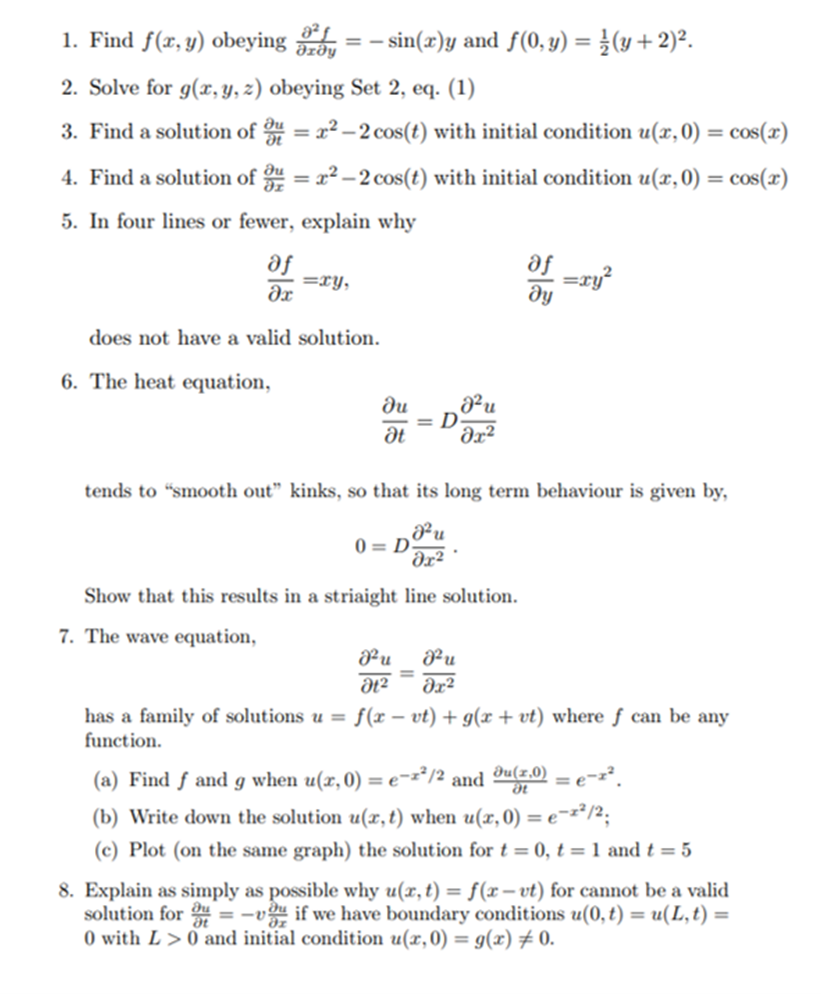1. Find f(x, y) obeying = - sin(x)y and f(0, y) = }(y +2)². %3D %3D
Advanced Engineering Mathematics
10th Edition
ISBN:9780470458365
Author:Erwin Kreyszig
Publisher:Erwin Kreyszig
Chapter2: Second-order Linear Odes
Section: Chapter Questions
Problem 1RQ
Related questions
Question

Transcribed Image Text:1. Find f(x, y) obeying
a² £_
Əzðy
- sin(x)y and f(0, y) = }(y + 2)².
2. Solve for g(x, y, z) obeying Set 2, eq. (1)
3. Find a solution of = x² – 2 cos(t) with initial condition u(x,0) = cos(x)
4. Find a solution of u = x2 -2 cos(t) with initial condition u(x,0) = cos(x)
%3D
5. In four lines or fewer, explain why
af -ry
se
=xy,
dx
ду
does not have a valid solution.
6. The heat equation,
du
= D
dx²
tends to “smooth out" kinks, so that its long term behaviour is given by,
0 = D
Əx²
Show that this results in a striaight line solution.
7. The wave equation,
Pu
Pu
has a family of solutions u = f(x – vt) + g(x + vt) where ƒ can be any
function.
(a) Find f and g when u(x,0) = e=z*/2 and ®u(z.0) = e-z².
*/2;
(b) Write down the solution u(x, t) when u(x,0) = e°
(c) Plot (on the same graph) the solution fort=0, t = 1 and t = 5
8. Explain as simply as possible why u(x, t) = f(r – vt) for cannot be a valid
solution for = -v if we have boundary conditions u(0, t) = u(L,t) =
O with L > 0 and initial condition u(x,0) = g(x) # 0.
Expert Solution
This question has been solved!
Explore an expertly crafted, step-by-step solution for a thorough understanding of key concepts.
Step by step
Solved in 2 steps with 1 images

Recommended textbooks for you

Advanced Engineering Mathematics
Advanced Math
ISBN:
9780470458365
Author:
Erwin Kreyszig
Publisher:
Wiley, John & Sons, Incorporated

Numerical Methods for Engineers
Advanced Math
ISBN:
9780073397924
Author:
Steven C. Chapra Dr., Raymond P. Canale
Publisher:
McGraw-Hill Education

Introductory Mathematics for Engineering Applicat…
Advanced Math
ISBN:
9781118141809
Author:
Nathan Klingbeil
Publisher:
WILEY

Advanced Engineering Mathematics
Advanced Math
ISBN:
9780470458365
Author:
Erwin Kreyszig
Publisher:
Wiley, John & Sons, Incorporated

Numerical Methods for Engineers
Advanced Math
ISBN:
9780073397924
Author:
Steven C. Chapra Dr., Raymond P. Canale
Publisher:
McGraw-Hill Education

Introductory Mathematics for Engineering Applicat…
Advanced Math
ISBN:
9781118141809
Author:
Nathan Klingbeil
Publisher:
WILEY

Mathematics For Machine Technology
Advanced Math
ISBN:
9781337798310
Author:
Peterson, John.
Publisher:
Cengage Learning,

